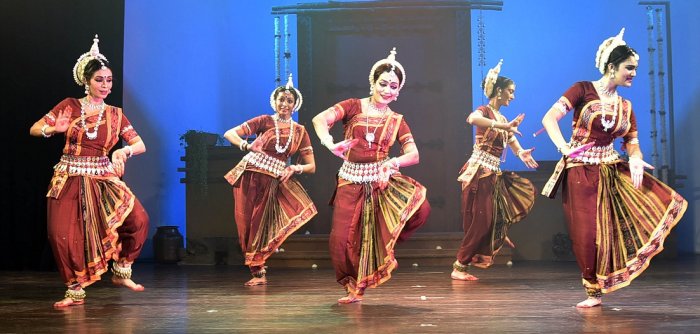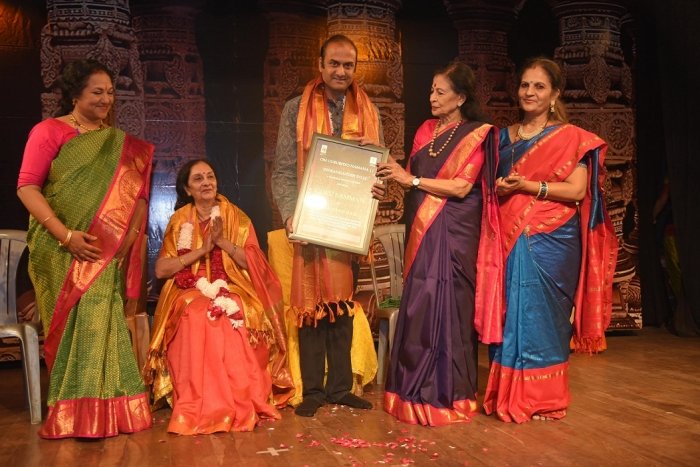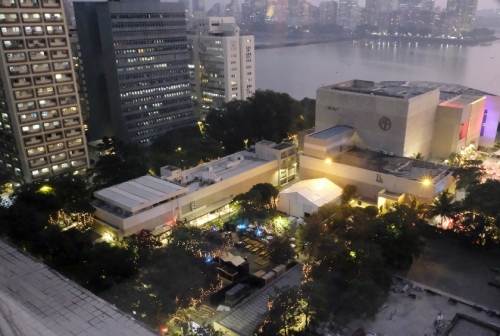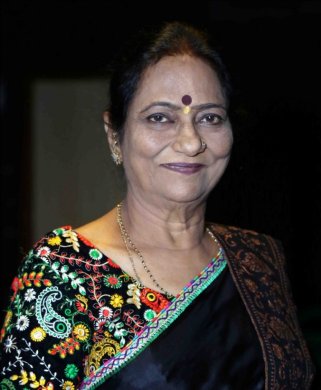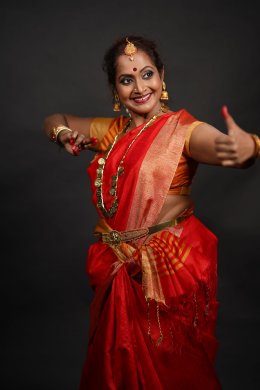So, as the Gregorian calendar year ends and a new one starts, what are our principal take home points?1. Dancers never had it so good! Even ordinary ones are busy dancing here, there, everywhere. Dubai, London, Odisha, Kerala. USA of course is second home to most. Add the odd Australia or Africa in between and our dancers, if not dance, has truly gone global. There are number of festivals and functions, affording most an opportunity to show their talent, or often, the lack of it! Some are very active with huge outreach thanks to real art; others thanks to their overzealous husbands / godfathers / sidekicks / students / parents / forced fan club or lovers besotted with them! They spend many office hours posting pouting pics on FB as if they are wares! And art is a commodity. They have made it so.
Read more in the site
Sarita Mishra, disciple of Yudhisthir Nayak and Bichitrananda Swain, moved in 2013 to Bangaluru. She established Adhyasha Foundation to teach Odissi with a cross section of disciples from diverse fields - banking, designing, professional interior designers, from IT, housewives, dancers from different dance styles and also foreigners. Within a short time, there was rapid growth of the foundation with the result that Sarita set up few branches. Within a short time, she has won appreciation from local established senior dancers and gurus and her two day annual festival is eagerly awaited.
Read more in the site
End-November and early December saw quite a pleasant outburst of choreographic creativity in the eastern metropolis, on both classical and contemporary fronts. While Kathak brought out a novel linkage with Baul singing of the village Bengal, Odissi saw a wonderfully vivid tryst of the women dancers with their inner domain, alongside gorgeous sets and subliminal illumination. On one side, Bharatanatyam went back to the Upanishad mooring of Satyam, Jnanam, Anantam; on the other side was an exhilarating contemporary exploration with "hugging the floor", in a near literary sense. To cap it all, there was an inner, extrapolated journey of classical dance visualized in a sumptuous stage. All in all, the exhilaration induced a euphoric sense of joy with a nip in the air, to match!
Read more in the site
Entertainment is an activity performed to hold an audience's attention with the purpose of delivering pleasure.Dance is a performing art form consisting of purposefully selected movements with a symbolic aesthetic value.Classical means a representation of an exemplary standard within a sufficiently long-established form or style.Considering these definitions, a classical dance performance can be defined as: A standard form or style of purposefully conceived movements that are specifically selected with the purpose of keeping an audience's attention. This, however, alters the meaning and intention of a classical dance performance.As I sat to watch an extravagant spectacle of a classical dance production by an extremely popular classical dance company from Bangalore, whose dancers are revered as young stars, I could not but help observe aspects that now dictate the intention of this process, its consequences, and its success factors.
Read more in the site
It is either everything or nothing when it comes to performance opportunities for a dancer in India. Performance space has been cornered by a handful of dancers who in most cases have had the good fortune to combine talent with power to influence the right decision making forces. Make no mistake; the latter has a big role to play in the scheme of things.What happens within the Guru/shishya teaching and learning arena remains largely outside reflection in the performance circuit. Which is why Ashok Vajpeyi, under the Raza Foundation umbrella of activities, very astutely started Uttaradhikar series for the young dancers, many of who would seem to struggle endlessly for platforms to perform. He is providing a regular platform (at least once a month) but on the recommendations of the Guru, who ultimately will be judged on the basis of the student's calibre. Two day events feature one promising young musician and one dancer every evening.
Read more in the site
Femme Fatale has usually been a pejorative term in the English language. But in the Dionysian world of theatre - first celebrated for the god of wine in ancient Greece -- Femme Fatales could very aptly describe the brave feminine front that has emerged in the two theatre-conscious metropolises. In Delhi, this critic knew the quartet of fiery female directors from the charmed circle of NSD: Neelam Mansingh, Anuradha Kapoor, Kirti Jain and Tripurari Sharma who have, together, created virtually a creative storm in the world of avant garde theatre in Hindi, and Joy Michael of 'Yatrik' in English theatre. In Kolkata, following the exemplary footsteps of the iconic Tripti Mitra - whose directorial oeuvre, beginning from Dakghar (1957), her solo classic Aparajita (1971), her Hindi ventures Guria Ghar (1980) and Sanjh Dhaley (1985), up to her last direction, Sarisrip (1987) had created waves among the cognoscente -- the suave Sohag Sen appeared and there has been no looking back ever since.If one attempts a very brief recapitulation of the thirteen major women directorial talents active today in the Kolkata drama scene - in no particular chronological order -- whose impact on Bengali theatre has been nothing less than an artistic Tsunami, Sohag Sen would stand foremost, with her forte in depicting urban middle class. Having directed plays by dramatists as varied as Mahesh Elkunchwar and Botho Strauss, her association with theatre and allied media spans a period of almost sixty years. As an actor, she started her career under the guidance of the legendary Utpal Dutt in the year 1969 and her latest directorial venture Chhota Chabi (reviewed in these columns), was very well received in 2019.
Read more in the site
On 28th November all roads led to Nariman Point to National Centre for the Performing Arts in Mumbai. The occasion was the grand celebrations of 50 years of the Centre. Associated with NCPA for more than 40 years, it was for me a sentimental journey. The large crowd of aficionados, dancers, musicians, painters, drama directors, actors, music lovers, in particular from the Parsi community, moved to Jamshed Bhabha Theatre, the large auditorium named after Jamshed Bhabha, the patron and Trustee of NCPA. Almost modeled on the Garnier, Paris Opera House, with two side marble staircases and imposing foyer, it was bustling with who is who of Mumbai's art loving public.
Read more in the site
(An earlier, slightly shorter version was presented at the Ocean Dance Festival, November22-25, 2019, at Chittagong, Cox's Bazar, Bangladesh, under World Dance Alliance-Asia Pacific)PropositionIt is a truism that, both individually and collectively, one tends to grow with time and change accordingly. Individually, one comes to grips with sex; grows to fathom the meaning of death; and so on. Collectively, the whole society changes with time. It is proposed that as a collective genre, classical dance of Indian sub-continent should relate to changes in their environment and discard MYTHOLOGY as their enduring 'sahitya' since the latter has lost its relevance to modern times. Classical dance - while fully carrying forward its techniques and treatment, and its highly developed aesthetics - should communicate to the modern society for deriving its contents for 'sahitya', as other sub-continental visual and performing arts have done in the recent years.
Read more in the site
Undeterred by years of choppy sea winds steadily weathering its stone carvings, Konark Temple stands as an architectural poem of unparalleled magnificence in salutation to the Sun God. The Konark Festival of Dance, with a massive open air stage overlooking the tiers of the Mahamandapa (the only part of the temple fully intact) in the distant backdrop, initiated by the Odissi Research Centre as a small beginning in 1969, has grown into a mammoth event held under the auspices of Odisha Tourism Department and the State Sangeet Natak Akademi, attracting tourists from all areas. With Chinese lanterns and tombas hanging from trees and buildings, and Pant Niwas lit up, the small township has a buzz, looking decked for a wedding. Walking through illuminated gardens and pathway decorated with large Rangoli patterns, one reaches the open-air auditorium with a seating capacity of 5000, which not infrequently, is filled to near capacity watching the dances.
Read more in the site
Sangeet Natak Akademi awardee (Kathak) for the year 2017, Dr. Shobha Koser has been a catalyst in promotion of Indian arts and culture at large. An exponent of the Jaipur Gharana, she has been a prime disciple of the stalwart late Guru Kundan Lal Gangani, learning from him several gems which the Jaipur style of Kathak is famous for. Zest for teaching and imparting these age old traditions at heart, Shobha Koser has been actively involved for decades in rendering arts education through her renowned institution Pracheen Kala Kendra in Chandigarh.
A doctorate in dance from Punjab University, we interact with Shobha Koser at length about her artistic journey, her will to propagate arts, and what it takes to be an artist.
Read the interview in the site
The Kakatiyas, the second major dynasty of the Andhra region after the Satavahanas, were ardent patrons of art. Dealing with the classical and the regional dance forms of the Kakatiya period is the 13th century treatise Nrtta Ratnavali written by Jayasenapati, who surprisingly was the commander-in-chief of the elephant corps (gajasadhanika and senapati as the author himself puts it) serving ruler Ganapati Deva (1198-1262), between whom and the author existed an intimate bond with Jayappa becoming his brother-in-law. It was 'Ganapati Bhupala', who noting the talent and loyalty of young Jayana as he is referred to, put him under the right tutelage to be taught fine arts! And significantly the thousand pillared 13th century Ramappa Temple at Palampet (now declared a world heritage monument) near Warangal, the capital of the Kakatiyas built out of special floating bricks was by the then Chief of Army and Minister of Ganapati Deva.Its extensive inscriptional and sculptural evidence pointing to the dance forms existing in this region inspired Jayappa while writing Nrtta Ratnavali. This would seem to point to an era when dance was a popular art form attracting people from all disciplines - not excluding the army! Jayappa's deep respect for Bharata and the Natya Sastra are reflected in the starting chapters on classical dance. In fact, he mentions that were Bharata to come back and reflect upon what he, Senapati had written, he would be very pleased at how completely faithful he, Jayana had been to Bharata's Natya Sastra! The later chapters deal with Desi or regional dances and here one sees the influence of Sarangadeva who belonged to about the same period, and is the author of the Sangeeta Ratnakara which also dealt with the Desi forms.
Read more in the site
(Paper presented at the "Purush-ang" seminar organized by Central Sangeet Natak Akademi at Bhubaneswar on September 19, 2000)An important role in the formation of what we define today as Odissi dance was played in the first half of the 20th century by male artistes belonging to the performing art scene of those days. At the time when the devadasi tradition had come to an end and the gotipua tradition was looked upon as cheap and vulgar, a group of talented and versatile stage artistes infused new life into the dying dance scene.The emergence of the present day Odissi cannot be totally understood unless we place it in the context of the fertile atmosphere which the theatre movement of the first half of the last century and the artistes behind it provided. Among the artistes were Mohan Sunder Dev Goswami, Ramachandra Mania, Laxminarayan Patra, Lingaraj Nanda, Kartik Kumar Ghose, Brindavan Das, Kashinath Sahu, Durlav Chandra Singh, Kalicharan Patnaik, and Dayal Sharan. They were totally dedicated and committed to the cause of reviving the performing arts of Orissa. Each one of them was an exponent of more than one discipline, like music, drama direction, dance or stage craft and each one was a self made artiste, having acquired whatever expertise he had, more by observation than by undergoing a systematic training.
Read more in the site
There is no doubt that with Trayambakam, the latest choreographic work of Rasa United, Vanashree Rao has emerged as a brilliant choreographer. From a soloist and performing Kuchipudi with her husband Guru Jaya Rama Rao, her forays into choreographing works in three styles - Bharatanatyam, Kuchipudi and Mayurbhanj Chhau - with a brilliant group of male and female dancers, Vanashree sets the stage on fire! There is not a single dull moment throughout the presentation. It grips the audience from the word go. The electrifying dances by the male dancers to the pulsating music, mood lighting and excellent costumes, the visuals hold one's attention.
Read more in the site
For those who believe they cannot dance, here is a way to tick that off your bucket list. A recent paper by researchers at the University of Berkeley provides insight into how they could transfer moves from a dancer onto a person who could not dance. The result - a seriously impressive dance by an untrained amateur. While Artificial Intelligence (AI) has thus far been able to recreate voices and faces, dance was a new high. Although it involved impressive deep learning algorithms with a multi-step transfer process, the product mapped the bodily motion from a trained dancer to a novice very convincingly.
Read more in the site
In the early 1960s, Martin Luther King II announced, standing under the shadows of Abe Lincoln’s Memorial in Washington, DC, to the Blacks of the States: I have a dream… Over half a century later in the late 2010s, Vikram Iyenger too declared, standing beside the ruins of the dilapidated Gem Cinema in Central Kolkata, to the art-lovers of the eastern metropolis: I have a dream…If King had contemplated the much larger domain of freedom from the bondage of slavery for his people, the vision of Iyengar, a renowned Kathak dancer groomed under Rani Karnaa, was: “A hub for the practice, discourse and presentation of dance and movement-work in Kolkata … a space to think, know, talk, imagine dance … a home in a country that boasts of innumerable movement expressions from dance to martial arts.” He elaborated, “This is the big dream, and we invite everyone to join us on this adventure...”Unlike the American Black’s freedom from bondage, Iyengar’s habitat for the art of dance has not yet materialized, the Gem’s site having proved to be too huge and too ramshackle, and there being no other site currently in view. Yet, Iyengar and his ‘Pickle Factory’ – a name he coined from a chance visit to a Chinese friend’s factory for manufacturing sauce – have pressed on regardless in their quest. Meanwhile, since 2018, Pickle Factory has been offering a delectable dance fair to the dilettante of the city. Only from August 2018 to October 2019, there have been 30 programmes; artistes have participated from the USA, the Philippines, Lithuania, Switzerland, China, Wales and Australia, apart from India; there have been 11 partners and 8 venues have been explored in Kolkata, Delhi and Bolpur (Shantiniketan). This critic witnessed three major events and here is the overview.
Read more in the site
"Every day brings you the chance to take a deep breath, kick off your shoes and Dance
When you hit a wall, climb over it, crawl across it or just dance on top of it."- Oprah Winfrey
We live in an age of crass cacophony. When a 29 year old priest slaps a 50 year old female devotee right in front of the sanctum in the CHIDAMBARAM temple and immediately flees the scene, we are staring at a scenario where there are no safe spaces and no automatic sanctuaries. When the #METOO accused just one year ago are not just roaming around scot free but also performing in several December sabhas and receiving awards, we are facing a dire landscape of broken rules and splintered hopes.It is not enough anymore for our politics to be separate from our art. No amount of dancing and praying to Shiva, Vishnu, Krishna, and Devi can sublimate the anarchy of our times. No shouting and screaming about disrobing Draupadi or humiliating Sita will suffice. The praise of BEAUTY is just not enough anymore. For our art to be in sync with our lives we must embrace the turmoil of our times and find a way to enfold it in our artistic practice.
Read on...
